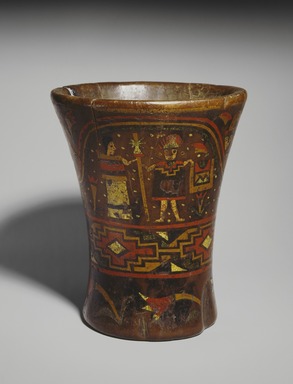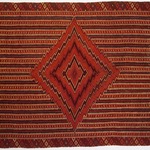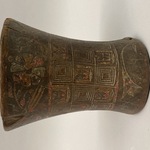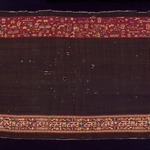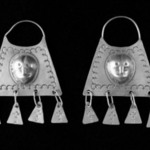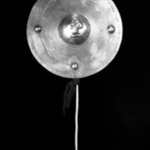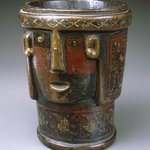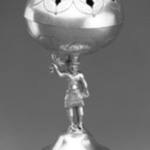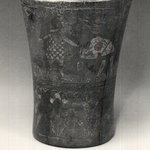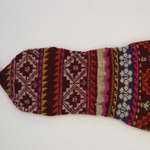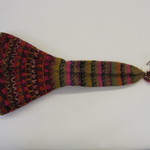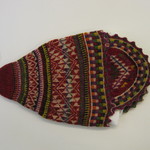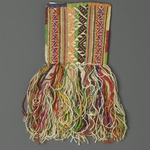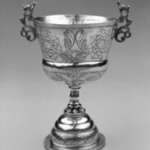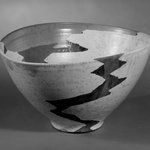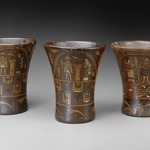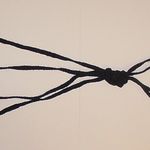

Quechua. Qero Cup, 16th – 17th century. Wood; lacquered, 7 3/8 x 6 15/16in. (18.7 x 17.6cm). Brooklyn Museum, Museum Expedition 1941, Frank L. Babbott Fund, 41.1275.5. Creative Commons-BY (Photo: Brooklyn Museum, 1993.2_64.210.2_41.1275.5_SL3.jpg)
Qero Cup
Arts of the Americas
The kero cup form originates with the Inca. The original decorations included abstract geometric patterns. After the arrival of Europeans, the kero evolved to include pictorial scenes, a European convention, but its function remained the same. Kero cups were used to drink chichi (maize beer) in ritual ceremonies, for instance in the sealing of a deal or agreement.
Although the kero looks similar to a European or North American colonial beaker, the two forms developed independently. The similarity of both cups in form and function created a link between Spanish and native cultures, reflecting the role of things in building cultural connections.
Although the kero looks similar to a European or North American colonial beaker, the two forms developed independently. The similarity of both cups in form and function created a link between Spanish and native cultures, reflecting the role of things in building cultural connections.
CULTURE
Quechua
MEDIUM
Wood; lacquered
DATES
16th – 17th century
PERIOD
Colonial Period
DIMENSIONS
7 3/8 x 6 15/16in. (18.7 x 17.6cm) (show scale)



COLLECTIONS
Arts of the Americas
ACCESSION NUMBER
41.1275.5
CREDIT LINE
Museum Expedition 1941, Frank L. Babbott Fund
MUSEUM LOCATION
This item is not on view
CAPTION
Quechua. Qero Cup, 16th – 17th century. Wood; lacquered, 7 3/8 x 6 15/16in. (18.7 x 17.6cm). Brooklyn Museum, Museum Expedition 1941, Frank L. Babbott Fund, 41.1275.5. Creative Commons-BY (Photo: Brooklyn Museum, 1993.2_64.210.2_41.1275.5_SL3.jpg)
IMAGE
overall, 1993.2_64.210.2_41.1275.5_SL3.jpg. Brooklyn Museum photograph, 2023
"CUR" at the beginning of an image file name means that the image was created by a curatorial staff member. These study images may be digital point-and-shoot photographs, when we don\'t yet have high-quality studio photography, or they may be scans of older negatives, slides, or photographic prints, providing historical documentation of the object.
RIGHTS STATEMENT
Creative Commons-BY
You may download and use Brooklyn Museum images of this three-dimensional work in accordance with a Creative Commons license. Fair use, as understood under the United States Copyright Act, may also apply.
Please include caption information from this page and credit the Brooklyn Museum. If you need a high resolution file, please fill out our online application form (charges apply).
For further information about copyright, we recommend resources at the United States Library of Congress, Cornell University, Copyright and Cultural Institutions: Guidelines for U.S. Libraries, Archives, and Museums, and Copyright Watch.
For more information about the Museum's rights project, including how rights types are assigned, please see our blog posts on copyright.
If you have any information regarding this work and rights to it, please contact copyright@brooklynmuseum.org.
RECORD COMPLETENESS
Not every record you will find here is complete. More information is available for some works than for others, and some entries have been updated more recently. Records are frequently reviewed and revised, and we welcome any additional information you might have.
